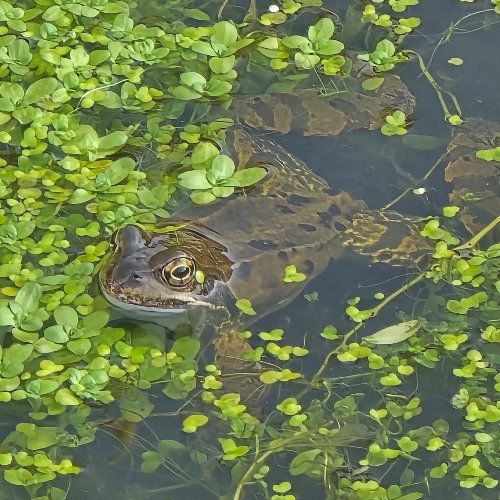History of... English Springer Spaniel
Name:
Common Frog
Scientific Name:
Rana temporaria
Family:
Ranidae
Conservation Status:
Least concern
Habitation:
Garden ponds, lakes, woodland, grassland, hedgerows, gardens.
Frogs have long been an integral part of the natural landscape in the United Kingdom, playing various roles in the ecosystem. Serving as both predator and prey, frogs also help control insect populations, making them important components of local ecosystems.
They have also captivated the imagination of people through folklore and cultural significance. There are three main species of frogs, the common frog, pool frog, and marsh frog. Each species has its own unique characteristics.
The adult common frog has a body length of 6 to 9 centimetres (2.4 to 3.5 in) and weigh around 22.7 g (0.80 oz). The female is usually slightly larger than the male.
Its back and flanks vary in colour from olive green to grey brown, brown, olive brown, grey and yellow. Common frogs can lighten and darken their skin to match their surroundings. During the mating season males' throats often turn white, and their overall colour is generally light and greyish, whereas the female is browner, or even red.
Outside the breeding season, common frogs live a solitary life in damp wetland near ponds or marshes or among long grass.
They are normally active for much of the year, hibernating in the coldest months. In the most northern areas of their territory they may be trapped under ice for up to nine months of the year, recent studies have shown that in these conditions they remain active in temperatures close to freezing. In the UK common frogs typically hibernate from late October to January. They emerge as early as February if conditions are favourable, and migrate to bodies of water such as garden ponds to spawn.
Common frogs hibernate in running waters, muddy burrows, or in layers of decaying leaves and mud at the bottom of ponds or lakes primarily with a current. The oxygen uptake through the skin is enough to sustain the needs of the cold and motionless frogs during hibernation.
Frogs have three distinct stages of development.
Frogspawn:
Frogs will often return to the pond where they born and will repeat this journey year after year. When mating, a male will attach himself to a female and they will remain attached for up to 24 hours while eggs are laid and fertilised. The males fertilise the eggs by spraying them with sperm. The female lays between a few hundred upto 5.000 eggs to increase the chances that more will survive to adulthood, as they are vulnerable to a number of predators, only around one in 50 eggs make it.
Frogspawn appears in ponds in early spring when the weather is just starting to get warmer and the days lighter. It is found just below the surface of shallow, still water, usually amongst dense vegetation to give the eggs some protection.
You can tell the difference between toad spawn and frogspawn by the shape of the eggs, toad spawn is long pearl like ribbons of eggs rather than large clumps that forms with frogspawn.
Tadpoles:
The tiny black dots within the frogspawn are the earliest development of a young frog, known as tadpoles. After 1-3 weeks, the tadpole emerges from the egg, they initially eat the yolk of their egg, but after a few days, they need to feed. Tadpoles remain in water, feeding on plant material and nearby vegetation.
Frogs:
The legless, water-bound tadpoles slowly metamorphose into frogs over the next 14 weeks. The tadpole’s tails shrink away and skin grows over their gills. Amazingly, tadpoles are able to control the timing of their transformation. If they're living in a dangerous environment, they will metamorphose more quickly. On the other hand, if their pond has plenty of food and few predators, or if it is cold on land, tadpoles can delay their development by several months.
Once the tadpole’s body has developed and formed lungs to allow them to breathe above water, they begin exploring the land, but stay close to their pond. Their diet starts to include larger items such as flies, slugs and snails. The transformation is now complete; our small tadpoles have become young froglets!
Frogs can take up to four years to develop to full maturity.
Frogs play a vital role in the delicate balance of the UK ecosystem. As both predators and prey, they help regulate insect populations and serve as prey for birds and other wildlife. Additionally, their tadpoles contribute to nutrient recycling in ponds, keeping our wetlands healthy and vibrant.
Long before humans roamed the lands of the UK and as the glaciers were retreating, frogs were already making a splash in the prehistoric world. Fossilized remains of frogs found in the UK reveal a rich history dating back millions of years. These ancient artefacts offer valuable insights into the behaviour and habitats of frogs in prehistoric times, highlighting their resilience and adaptability over geological eras.
UK frog species have developed a range of adaptations due challenges of their surroundings. From camouflaged skin for blending into mossy ponds or their powerful legs for leaping away from predators, these adaptations showcase the incredible ability of frogs to adapt to differing ecosystems.
Despite their shared amphibious heritage, UK frog species exhibit a surprising diversity in size, coloration, and behaviour. From the tiny common frog to the boisterous marsh frog, each species brings its own unique charm to the British countryside. This rich tapestry of frog diversity adds colour and character to our natural landscapes.
Throughout history, frogs have been associated with many myths and folklore in the UK. From a symbolic significance in Celtic traditions to their magical transformations in fairy tales, frogs have captured the imagination of storytellers and folklore enthusiasts alike.
Photograph: Ian Stephens


